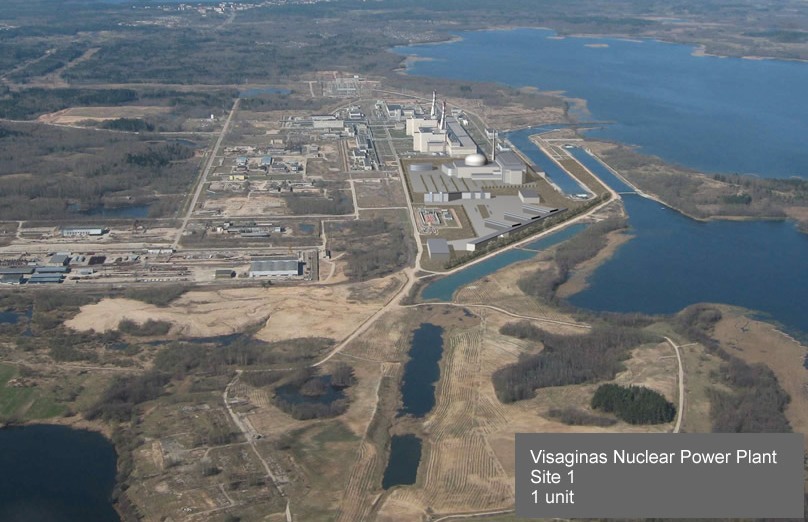
Baltic Nuclear Power Plant Project Contends with Extraneous Issues
Publication: Eurasia Daily Monitor Volume: 9 Issue: 35
By:

The Baltic regional nuclear power plant project, at Visaginas in Lithuania, is moving forward despite unfavorable international circumstances. At this point, the adverse circumstances are not internal to the project. They are extraneous to it, originating variously from Russia and from Europe.
Last July, Lithuania selected Hitachi-GE, a consortium of Japan’s Hitachi and General Electric of the US, as the strategic investor for the project. American participation made this option especially attractive in the Baltic region (see EDM, July 19, 2011). Estonia and Latvia plan to join Lithuania as shareholders in this regional project. Cost estimates range from 4 billion Euros ($5.27 billion) to 6 billion Euros ($7.91 billion). The partner countries would receive electricity proportionately with their respective shares in the investment. Hitachi-GE participates in a dual role as strategic investor and provider of the technology and nuclear fuel. It plans to install two Advanced Boiling Water Reactors (ABWRs), with a capacity of 1,300 megawatts each. This is a third-generation nuclear reactor type with a proven record of reliability.
Meanwhile, Russia’s Rosatom advertises the competing project of a “Baltic nuclear power plant” of its own, near Kaliningrad. It proposes to supply the three Baltic States, as well as Poland and Germany with electricity from the Kaliningrad plant in the future. This project envisages two Russian VVER-type (pressurized water) reactors, with a capacity of 1,200 megawatts each, to be completed by 2016 and 2018, respectively (BNS, February 13).
The Kaliningrad project’s foremost goal is strategic-geopolitical, rather than commercial. It aims to pre-empt the Visaginas project, threaten it with redundancy, reinforce the Baltic States’ dependence on Russian energy, co-opt Poland into a Russian-dominated Baltic regional market, and break into Germany’s electricity market.
Moscow has recently subcontracted part of the work on the Kaliningrad project to the French conglomerate, Alstom. Under the February 1 agreement, Alstom’s nuclear power division will supply 380 million Euros ($501 million) worth of non-nuclear equipment (mainly steam turbines and generators) for the Kaliningrad project. The French company had established a joint venture with Russia’s Atomenergomash in 2007, but the venture has remained idle amid the general economic downturn. Alstom’s inputs into the Kaliningrad project will run via this joint venture. Alstom becomes the first-ever European company to enter Russia’s nuclear power plant construction business. According to the French company, its participation in the Kaliningrad project guarantees “100 jobs for four years in France” (Le Figaro, February 3).
Poland considered joining the Visaginas project, but suspended its involvement in January. This came about haphazardly. The Polish Electricity Group (PGE), 51 percent state-owned, announced that it withdraws from the project altogether. The government then dismissed PGE’s CEO, whereupon a deputy finance minister (without authority to pronounce on energy policy) said that Poland was postponing its consideration of the Visaginas project, waiting for more favorable commercial terms. This procedure created confusion in the Baltic capitals (Eesti Paehvalet, January 29).
In Brussels, the European Court of Auditors (a body that checks the effectiveness of the use of EU funds) has just completed a review of decommissioning and operations at Ignalina, the Soviet-era nuclear power plant in Lithuania. The site of Visaginas is located next to Ignalina. Decommissioning delays can cast doubt on the start of the Visaginas project. Decommissioning of the Ignalina nuclear power plant is a joint Lithuanian-EU undertaking. The EU Auditors confirmed that the decommissioning is running behind schedule and above budget by wide margins. They found a time-lag of some three years and a funding shortfall of 1.48 billion Euros ($1.95 billion) at the moment. The company Nukem, specialized in nuclear plant decommissioning projects, is in charge of the troubled Ignalina project. Nukem was a German company when hired, but it soon metamorphosed into a Russian company. Cost overruns and time lags accumulated.
The EU Commission has already allocated 1.37 billion Euros ($1.80 billion) for Ignalina decommissioning operations through 2013. Lithuania has requested 800 million Euros ($1.05 billion) for the next EU budget perspective, 2014-2020; but the EU’s draft budget for that period envisages only 200 million Euros ($2.64 million) (on top of a 100 million Euro Lithuanian contribution). The EU Commission claims that it has thus far fulfilled its financial commitments to the Ignalina decommissioning project, cannot be expected to make up for funding shortfalls, and the ultimate responsibility rests with the member state (BNS, February 8; Delfi.Lt, February 13).
That argument could sound more convincing, had it not been the EU who required Lithuania to shut down Ignalina as a mandatory precondition to Lithuania’s accession to the EU, and without concern for a replacement. That plant had supplied the three Baltic States with electricity from its two RBMK-type reactors, commissioned in 1983 and 1987 respectively, with a capacity of 1,360 megawatts each. The EU demanded their closure as a safety precaution, stipulating this in the accession treaty with Lithuania. The two reactors were accordingly shut down in 2004 and 2009, respectively. That shutdown left the region with a deficit of electrical power. It forced countries to import electricity from Russia, raised costs to consumers, and added electricity dependence to the gas and oil dependence of the Baltic States on Russia.
Timely construction of the Visaginas nuclear plant is therefore imperative for these three states. As host country for this regional project, Lithuania expects to see the concession contract signed with Hitachi-GE during 2012; the shareholders’ agreement among Lithuania’s Visaginas, Latvia’s Latvenergo, Estonia’s Eesti Energia, and Hitachi-GE, in 2013; the start of construction work, in 2014, and the first electricity to be produced in 2020.




